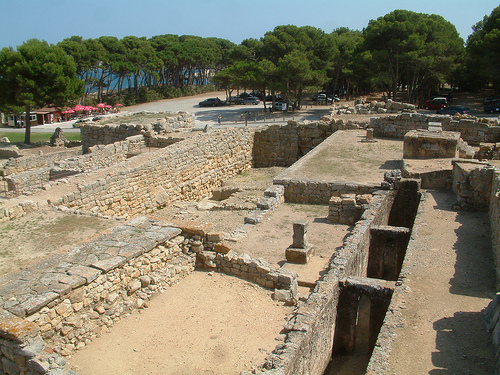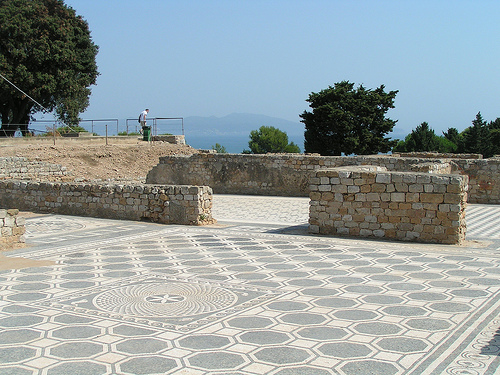The Greco-Roman ruins at Empúries are one of the most important archaeological sites in the whole of Spain.

The ruins at Empúries. Photo by Kai-Christian Bruhn.
Easy to get to on foot from l’Escala and with plenty of parking for visitors travelling from further a field, the ruins at Empúries make an interesting and educational day out. Located near the small sandy beach that was once the town’s harbour, the ruins can be easily tied in with a beach day during summer.
A short history lesson
Among the first settlers to land on the Costa Brava were the Phoenicians in around the year 575 BC, who founded the city of Emporion (which means trading place in Ancient Greek) on an island in the mouth of the Fluvia, up until then inhabited by a local tribe.
However, the settlers moved to the mainland by around 550 BC leaving the old city (Palaiapolis) behind and building the new city (Neapolis). The site of Palaiapolis later became the mediaeval village of Sant Martí d’Empúrias, which has since become part of the mainland, while Neapolis is the site of the Roman ruins of Empúries.
The settlement became the largest Greek colony in Iberia after developing into a major commercial and economic centre, located on the trading route between Marseille and the ancient city of Tartessos in Andalusia.
In the second Punic war fought between the Roman Empire and that of Carthage, Empúries sided with Rome and it was from here that the Roman conquest of Iberia began in 218 BC.
Following the arrival of the Romans in the peninsular Empúries enjoyed the privilege of being an independent city-state but during the Great Roman Civil War (49-45 BC) backed the wrong side; Julius Caesar’s victory over Pompey led to the end of the Roman Republic and the creation, in 27 BC, of the Roman Empire.
The result was that Empúries lost its autonomy and an outpost of Roman veterans was established nearby to control the area.
The excavations
Although some digging had taken place in the mid nineteenth century, systematic excavations at Neapolis only began in 1908 under the direction of archaeologist Emili Gandia i Ortega.

An uncovered area of mosaic flooring. Photo by Tristan Ferne.
The work was done on behalf of Barcelona’s Board of Museums in Barcelona under the orders of famed modernista architect Josep Puig i Cadafalch, and later, Pere Bosch-Gimpera, who was professor of Ancient and Medieval History at the University of Barcelona between 1916 to 1939.
The work continued throughout the twentieth century and continues to this day; it is estimated that less than a quarter of the site has yet been excavated.
What you see there
A visit to the ruins will take around 90 minutes and halfway round the tour you can visit the museum in which various artefacts are displayed. One difference between the Greeks and Roman constructions that latter would level the terrain in order allow the towns to be laid in a regular grid.
In the Greek town you can see the town’s defensive walls dating from the first century BC, a centre dedicated to Asklepiós, the Greek god of medicine, and area where fish sauces and preserves were made (today l’Escala is renowned for its anchovies), the public square where all the political, social and economic activity would take place, a drainage system dating from the second century BC, and (outside the museum on the beach) the jetty built by the Greeks shortly before the Romans arrived to deal with the increased commercial traffic, as well as mosaics.
The Roman town, which dates between the first century BC and the first century AD, has the recently excavated public baths on display, the forum, administration buildings and shops and a number of mosaics in one of the town’s largest houses.
Where it is
When is it open?
1st June to 30th September: 10.00 to 20.00
1st October to 31st May: 10.00 to 17.00 – Mondays closed
Tel: (+34) 972 770 208


3 Comments
How can I get to this site on public transport from Girona in a day trip?
I will be there in May.
There is a bus 5 times a day from Girona bus station to l’Escala, which is next to the train station. It departs at 09:15, 13:00, 15:45, 18:00 and 19:00 and takes an hour.
From l’Escala you can walk to the Empúries ruins. It is around 20 minutes on foot or you may be able to find a taxi.
For more info go here: https://www.moventis.es/es/lineas-horarios/lescala-girona
I hope that helps!
Thanks David that’s great!